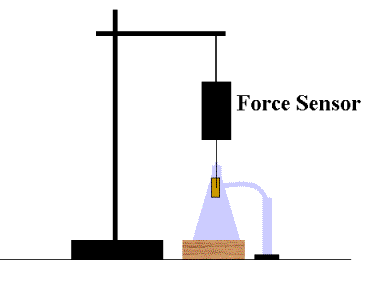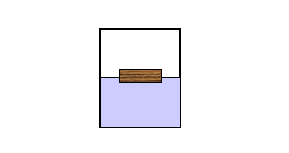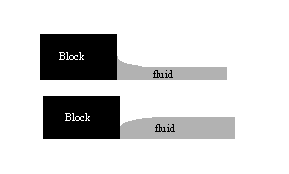

 PYL
105: Lab 9
PYL
105: Lab 9



Archimedes' principle
Archimedes' principle says: A body wholly or partially immersed in a
fluid is buoyed up by a force equal to the weight of the
fluid it displaces.
Part 1: Density of water
- Place an empty graduated cylinder on a balance,
determine its mass.
- Add some water, note the mass and the volume of the
water.
- Add more water and take measurements for a total of
five sets of masses and volume.
- Plot mass versus volume.
- Fit to a straight line and interpret the slope.
Part 2: Force as a function of volume displaced
- Connect a force sensor to the interface. Hang it from
a ring stand.
- Tare (zero) the force sensor while nothing is hanging
from it.
- Thread a string through the hole in the brass
cylinders and hang it from the force sensor.
- Set up a hose connecting the spout on a flask to a
graduated cylinder as shown below. (The path to the graduated cylinder must be
entirely downhill.)
- Get some paper towels. Fill the flask to the point at
which water spills over into the graduated cylinder. (Don't simply fill it up
to the point at which you think is the spout level, you should actually
observe some water spilling out.)

- You are going to lower the brass cylinder into the water, measuring
the tension (force sensor reading) and volume of water displaced (graduated
cylinder). You should have at least five measurements including an initial
measurement with no water displaced and a final measurement with the
cylinder fully immersed. Note: careless adjusting the clamp on the ring
stand can result in an undesired lifting of the force sensor and cylinder.
This will result in poor data. Loosen the clamp as little as possible to
change the height. Practice a few times before taking your data.
- Plot Tension versus volume displaced. Fit it to a
straight line. Determine what the slope should be theoretically. What is
the percent error?
Slope ( )
from graph |
Slope ( )
from theory |
Percent
Difference |
| | | |
Part 3. The density of brass.
- Method 1. Calculated volume.
- Measure the mass of the brass cylinder.
- Measure the radius r and height h of the cylinder.
- Calculate the density
rbrass
(mass/volume) of the cylinder in kg/m3.
Recall that the volume of a cylinder is
Vcyl = p
r2 h
- Method 2. Measured volume.
Note it was the cylinder volume that
displaced the water. Thus we could obtain the cylinder volume from the final
water displacement reading from Part 2.
- Method 3. No volume.
Neglecting any buoyant force due to air, the weight in air is
given by
Fweight = rbrass
g V
When the cylinder is submerged, there is an additional
force, the buoyant force, acting. It is given by
Fbuoyant = - rwater
g V
where the minus sign indicates that the buoyant force is in the up while
the weight was down. Derive an expression the density of brass rbrass that
involves your initial (not submerged) force Fi and final
(totally submerged) force Ff from above, but does NOT
include volume. In this method you should not use the volume you
calculated, but you can use the density of water (rwater =
1000 kg/m3).
Density of brass
Method 1 |
Density of brass
Method 2 |
Density of brass
Method 3 |
Average |
| | | | |
The nice feature of this last technique is that it does not require
any measurement or calculation of the volume. Apply the same technique
to measure the density of one of the short hexagonal shaped weights.
Also measure the density of one of the longer hexagonal shaped
weights.
| | Fi (N) | Ff (N) |
Density (kg/m3) |
| Small Hexagon | | | |
| Small Hexagon | | | |
Discuss the relative merits of these techniques. What is hydrostatic
weighing? What is it used for?
Part 4. Floating
If an object's density is less than water, it will float. That is,
it will be positioned at the surface of the water with only some of
its volume below the surface. If the object is in equilibrium then
its weight must be balanced by the buoyant force (assuming no other
forces are acting).
- Find the mass of a wooden block.
- Calculate its volume (length
´ width
´ height).
- Calculate the density in kg/m3.
- Place the block in the water and then determine
the volume of the block that lies below the surface
(length
´ width
´ submerged height).

- Next calculate the weight of the displaced water and
compare it to the weight of the block.
| Length (m) | Width (m) |
Height (m) | Submerged
Height (m) |
Weight
of block (N) |
Weight of water
displaced (N) |
Percent
Difference |
| | | | |
| | |
One possible difficulty with this measurement is in determining the amount
of the block that is below the surface. This is because fluids do not
meet the surface of the block at a right angle. Typically the
fluid-block interface will look roughly like one of the pictures below.

We say in the case on the top that the water "wets"
the surface. In this case, if you measured the length
of wetness to obtain the "submerged height," you would
tend to overestimate the submerged volume. Those of you
who have had chemistry may have seen/discussed this
phenomenon in connection with the meniscus. Comparing
the actual weight of the block to the calculated weight
of the water displaced, do you think you underestimated or
overestimated the displaced volume?



 PYL
105: Lab 9
PYL
105: Lab 9






